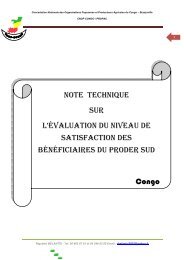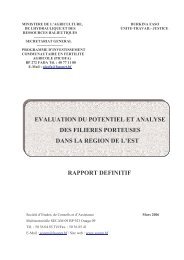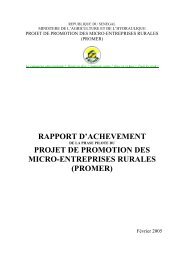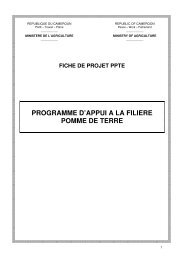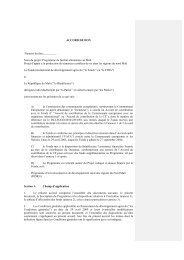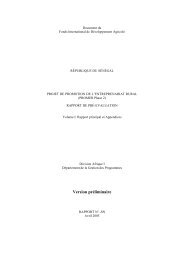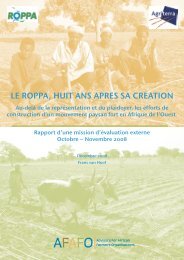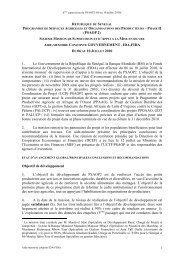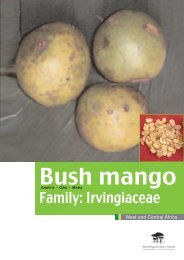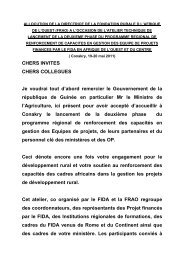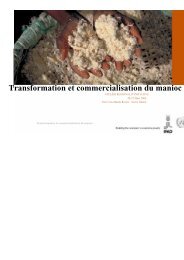Scaling Up the Fight Against Rural Poverty - FIDAfrique
Scaling Up the Fight Against Rural Poverty - FIDAfrique
Scaling Up the Fight Against Rural Poverty - FIDAfrique
You also want an ePaper? Increase the reach of your titles
YUMPU automatically turns print PDFs into web optimized ePapers that Google loves.
Development Goals.’ In this context scaling up means expanding, adapting, and sustaining<br />
successful projects, programs, or policies over time for greater development impact.”<br />
In <strong>the</strong> private commercial world, <strong>the</strong> profit motive and market competition drive economic agents to<br />
innovate and to scale up successful innovations. In <strong>the</strong> non-commercial world of public goods<br />
provision and development assistance bureaucratic rules, policy incentives and non-market<br />
mechanisms of competition guide <strong>the</strong> behavior of governments, of not-for-profit organizations and of<br />
international aid agencies. It has been easier to create incentives for innovation than to get<br />
governments, NGOs and international aid agencies to focus systematically on <strong>the</strong> scaling up agenda.<br />
Human nature, political forces and bureaucratic motives conspire to create a heavy focus on<br />
innovation, since new ideas, new initiatives and new beginnings are more interesting to individuals,<br />
politically more attractive and bureaucratically easier to justify than are thorough evaluation and<br />
replication of pilots.<br />
Of course, <strong>the</strong>re are spectacular successes of scaled up innovations in <strong>the</strong> development field: <strong>the</strong> River<br />
Blindness Program in West Africa, which helped largely to eradicate <strong>the</strong> wide-spread and deadly<br />
disease onchocerciasis; <strong>the</strong> Grameen Bank and BRAC programs of microcredit for poor people in<br />
Bangladesh; and <strong>the</strong> Progresa-Oportunidades Program in Mexico and similar conditional cash transfer<br />
programs elsewhere in Latin America, which helped tackle endemic poverty. Many o<strong>the</strong>r examples<br />
can be cited. 2 And a few governments, notably <strong>the</strong> Chinese authorities, have made scaling up <strong>the</strong><br />
driving motivation of <strong>the</strong>ir development approach. It is clear <strong>the</strong>refore that scaling up in development<br />
is possible. The real challenge is to make sure it happens whenever and wherever appropriate. This is<br />
nowhere near <strong>the</strong> case so far. On <strong>the</strong> contrary, <strong>the</strong> majority of development activities remain isolated,<br />
one-time interventions, like unconnected dots on a white page. 3 The great opportunity is to connect <strong>the</strong><br />
dots and assure that <strong>the</strong> outlines of an effective development strategy emerge. If each development<br />
agent makes scaling up of successful innovations her or his business, <strong>the</strong>re is a chance to reach <strong>the</strong><br />
ambitious development goals of <strong>the</strong> international community.<br />
B. Why scaling up for IFAD?<br />
IFAD was created in 1977 as an institution with a specific purpose as laid out in its establishment<br />
agreement (IFAD 1977, p. 4):<br />
“The objective of <strong>the</strong> Fund shall be to mobilize additional resources to be made available on<br />
concessional terms for agricultural development in developing Member States. In fulfilling<br />
this objective <strong>the</strong> Fund shall provide financing primarily for projects and programmes<br />
specifically designed to introduce, expand or improve food production systems and to<br />
streng<strong>the</strong>n related policies and institutions within <strong>the</strong> framework of national priorities and<br />
strategies, taking into consideration: <strong>the</strong> need to increase food production in <strong>the</strong> poorest food<br />
deficit countries; <strong>the</strong> potential for increasing food production in o<strong>the</strong>r developing countries;<br />
and <strong>the</strong> importance of improving <strong>the</strong> nutritional level of <strong>the</strong> poorest populations in developing<br />
countries and <strong>the</strong> conditions of <strong>the</strong>ir lives.”<br />
IFAD is a relatively small player in <strong>the</strong> area of rural development. The notion that its existence needs<br />
to be justified on grounds of adding value through innovation and catalytic impact leading to<br />
multiplication and replication on a larger scale is firmly embodied in its lending policies and criteria as<br />
2<br />
See Hartmann and Linn (2007) for examples from different sectors, and Spielman and Pandya-Lorch (2009) for<br />
agricultural and rural development.<br />
3<br />
The situation is made worse by <strong>the</strong> fact that official aid projects have declined in size as <strong>the</strong>ir number has<br />
rapidly grown in recent years. The median size of projects is now below $100,000. (Linn 2010)<br />
5



